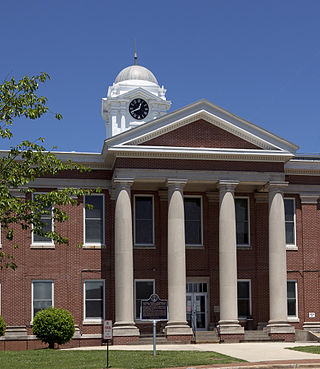
Jackson County is the northeasternmost county in the U.S. state of Alabama. As of the 2020 census, the population was 52,579. The county seat is Scottsboro. The county was named for Andrew Jackson, general in the United States Army and afterward President of the United States of America. Jackson County is a prohibition or dry county, but three cities within the county are "wet", allowing alcohol sales. Jackson County comprises the Scottsboro, AL Micropolitan Statistical Area, And Jackson county is included in the Scottsboro-Fort Payne combined statistical areas. It is the site of Russell Cave National Monument, an archeological site with evidence of 8,000 years of human occupation in the Southeast.

Livingston is a city in and the county seat of Sumter County, Alabama, United States and the home of the University of West Alabama. By an act of the state legislature, it was incorporated on January 10, 1835. At the 2010 census the population was 3,485, up from 3,297 in 2000. It was named in honor of Edward Livingston, of the Livingston family of New York.
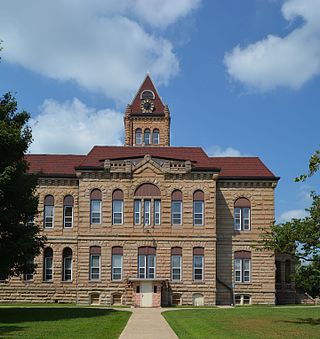
Carrollton Courthouse Square Historic District is a historic district encompassing the courthouse square and surrounding commercial district in Carrollton, Greene County, Illinois. The district is centered on the Greene County Courthouse, a limestone Romanesque Revival building built in 1891-92. The courthouse occupies an entire city block at the center of the district. The twelve quarter blocks surrounding the courthouse comprise Carrollton's only business district. Development in the area began in 1821, when the first courthouse was built; at the time, the square was surrounded by new houses. The only house remaining from this period is the Hodges House, which was built in 1829 and is now a historical museum. The square assumed its commercial character between 1830 and 1855, when several brick stores were constructed. After 1855, the square gained several two- and three-story commercial buildings, which form the predominant type in the district. In addition to the commercial buildings, Carrollton's public library and post office are also located on the square.

The Shackelford County Courthouse Historic District is a historic district in Albany, Texas. It is roughly bounded by South 1st, South 4th, South Jacobs, and South Pecan Streets, centered on the courthouse square. Added to the National Register of Historic Places in 1976, the district includes the Shackelford County Courthouse and a number of surrounding Victorian buildings dating from the late nineteenth and early twentieth centuries.

The Grove Hill Courthouse Square Historic District is a historic district in Grove Hill, Alabama. It is centered on the Clarke County Courthouse and the boundaries are roughly Cobb, Court, Jackson, and Main Streets. It features examples of Greek Revival and Queen Anne architecture. The district was added to the Alabama Register of Landmarks and Heritage on March 24, 1995, and to the National Register of Historic Places on April 30, 1998.
This is a list of properties on the Alabama Register of Landmarks and Heritage, sorted alphabetically by county. This list contains all entries for Pickens County through Winston County, the other listings may be found here. The Alabama Register of Landmarks and Heritage is an official listing of buildings, sites, structures, objects, and districts deemed worthy of preservation in the U.S. state of Alabama.
This is a list of properties on the Alabama Register of Landmarks and Heritage, sorted alphabetically by county. This list contains all entries for Madison County through Perry County, the other listings may be found here. The Alabama Register of Landmarks and Heritage is an official listing of buildings, sites, structures, objects, and districts deemed worthy of preservation in the U.S. state of Alabama.
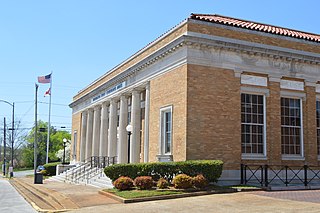
The Old Main Post Office in Athens, Alabama, also known as Washington Street Courthouse Annex, was built in 1933. Located one block from the Courthouse Square, the Neoclassical building was constructed by the Works Progress Administration. The front is divided by 8 Doric columns. Granite stairs flanked by original cast iron lamps lead to 3 sets of doors in the center bays. The lobby features marble floors, wainscoting, pilasters, and door trim.
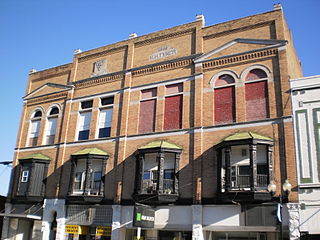
The Hartford City Courthouse Square Historic District is located in Hartford City, Indiana. Hartford City has a population of about 7,000 and is the county seat of Blackford County and the site of the county courthouse. The National Park Service of the United States Department of the Interior added the Hartford City Courthouse Square Historic District to the National Register of Historic Places on June 21, 2006 — meaning the buildings and objects that contribute to the continuity of the district are worthy of preservation because of their historical and architectural significance. The District has over 60 resources, including over 40 contributing buildings, over 10 non-contributing buildings, 1 contributing object, 8 non-contributing objects, and two other buildings that are listed separately in the National Register.

The Fayette County Courthouse Historic District is a historic district covering the downtown central business district of Fayette, Alabama. The majority of the buildings in the district were constructed soon after a fire destroyed the town in 1911; the architectural styles reflect common styles in commercial buildings around the Southern United States at the beginning of the 20th century. The district was listed on the National Register of Historic Places in 1976, and the boundaries of the district were increased in 2014.
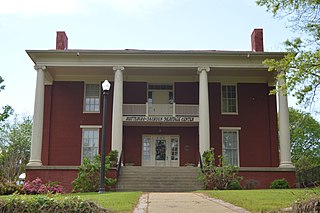
The Brown–Proctor House is a historic residence in Scottsboro, Alabama. The house was built in 1881 by John A. Brown, who sold it just one year later. He sold the house to General Coffey, who bought the house for his daughter Sarah, for 3,200 dollars. John Franklin Proctor, a politician who served in the Alabama Legislature from 1892 through 1899 and was an attorney for the Scottsboro Boys in 1931, purchased the house in 1907. Proctor made numerous renovations to the house, including altering the two-story front portico with Tuscan columns into its current state of a single-level porch supported by Ionic columns with a central second floor balcony. A three-room addition was also built onto the back of the house, adding to the central hall plan of the original house. After his death in 1934, Proctor's family owned the house until 1981.

The College Hill Historic District is a historic district in Scottsboro, Alabama. The neighborhood was the first subdivision to be platted in Scottsboro. The area takes its name from the Scott Male and Female Academy, which was built in 1878. The site has been occupied by schools since; the present building was constructed in the 1930s and currently houses the administration offices of the Scottsboro Board of Education. The district contains 14 houses, 10 of which were built between 1890 and 1929, three in the 1930s, and one in the 1970s. The earlier houses are primarily Vernacular styles, although the later construction includes Bungalow and English Cottage-style houses popular at the time. The district was listed on the Alabama Register of Landmarks and Heritage in 1982 and the National Register of Historic Places in 1983.

The Scottsboro Memphis and Charleston Depot is a historic train station in Scottsboro, Alabama, USA. Built in 1861 on the eve of the American Civil War, the depot is one of three remaining antebellum depots in Alabama built by the Memphis and Charleston Railroad, and the only one outside Huntsville. On January 8, 1865, it was the site of a skirmish between members of the 101st and 110th U.S. Colored Infantry Regiment and Confederate forces which resulted in the retreating rebels setting fire it.

The Magnolia Commercial Historic District encompasses the historic heart of Magnolia, the county seat of Columbia County, Arkansas. It includes the courthouse square and most of the buildings which face it, as well as buildings along Calhoun and Jackson Streets. The centerpiece of the district is the square itself and the Columbia County Courthouse, a Renaissance Revival structure built in 1905 to a design by W. S. Hull. The square is lined with mostly brick-faced buildings built between about 1899 and 1910, and between 1938 and 1958, when the city experienced a second building boom. The oldest known surviving building, then as now housing a pharmacy, is located at 111 S. Court Square. One prominent building from the second building phase is the Cameo Theater Building, an Art Deco design built in 1948.

The Athens Courthouse Square Commercial Historic District is a historic district in Athens, Alabama. Athens was founded in 1818 when Robert Beaty and John D. Carroll began selling tracts of land. The following year, the town was chosen as the county seat of the newly formed Limestone County. Commercial development around the courthouse square was swift, aided by the strong cotton market. The town and courthouse suffered heavy damage during the Civil War in the Battle of Sulphur Creek Trestle. Athens' revival was slowed by major fires in 1882, 1894, and 1897, as well as the Panic of 1893. Redevelopment was spurred again in the 1910s and 1920s by a diversified economy with increased manufacturing, and in the 1930s by electricity provided by the Tennessee Valley Authority. Notable buildings in the district are the Limestone County Courthouse, built in 1919 in Neoclassical style with Palladian influences. The Old Post Office building was completed in 1933. The district was listed on the National Register of Historic Places in 1997 and the Alabama Register of Landmarks and Heritage in 2012.
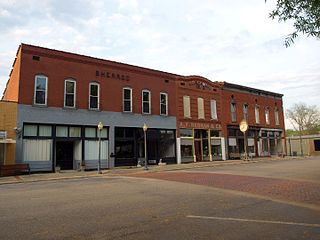
The Courtland Historic District is a historic district in Courtland, Alabama. Courtland was founded in 1818 and incorporated the following year. Its location was chosen to be close to the Tennessee River to facilitate transportation, but also close to cotton plantations to the south. The town's founders envisioned becoming the county seat of the newly formed Lawrence County, but the title instead went to Moulton. Many of the earliest structures in Courtland were built of logs, and were later replaced with frame and brick buildings. Development plateaued by 1830, but received a slight bump from the Tuscumbia, Courtland and Decatur Railroad beginning in 1834. The oldest houses in the district date from this era, including the 1828 Federal-style John McMahon House and several I-houses.

The Moulton Courthouse Square Historic District is a historic district in Moulton, Alabama. Moulton's development began in 1820, when it was chosen as the county seat of the newly formed Lawrence County. The first courthouse was a log structure; a log jail on the west side of the square operated until 1911, when it was replaced with the current, 3-story brick jail and courthouse annex. Due to its lack of rail and river connections, development around the square remained sparse. The log courthouse was replaced in 1860 with a two-story, square building with Classical Revival details. The cotton economy of Lawrence County rebounded after the Civil War with the construction of several cotton gins, though nearly all of the structures built along the square in the late 19th century were later razed and replaced. The oldest extant buildings in the district were built in 1911: the three-story courthouse annex, and the two-story, stone faced Citizens' Bank building. The northern part of Market Street, on the west side of the square, were constructed during the early 1920s. Lawrence County's economy received a boost from New Deal programs, most notably the Tennessee Valley Authority's fertilizer program and construction of Wheeler Dam. Most of the square's buildings were constructed during the late 1930s and 1940s, in contrast to most historic downtowns around the South. The current courthouse was completed in 1936. The district was listed on the National Register of Historic Places in 1998.
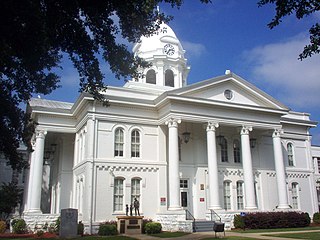
The Colbert County Courthouse Square Historic District is a historic district in Tuscumbia, Alabama. It contains 22 buildings and residences centered on the Colbert County Courthouse.

The Chambers County Courthouse Square Historic District comprises the central portion of LaFayette, Alabama, centered on the Chambers County Courthouse. The courthouse is located in a square, surrounded by an early 20th century commercial district on LaFayette Street, Alabama Avenue, First Street SE and First Avenue. The district includes 63 buildings, of which 45 are considered contributing features. It is described as one of the most intact courthouse squares in Alabama.





















